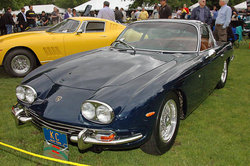Difference between revisions of "Lamborghini 400GT"
m |
m |
||
| Line 1: | Line 1: | ||
| − | + | {{X}} | |
{| border=1 align="right" cellpadding=2 cellspacing=0 width=250 style="margin-left:3em; margin-bottom: 2em;" | {| border=1 align="right" cellpadding=2 cellspacing=0 width=250 style="margin-left:3em; margin-bottom: 2em;" | ||
|- | |- | ||
| Line 52: | Line 52: | ||
A special, one-off version called the [[Lamborghini 400GT Monza|400GT Monza]] was built by Neri and Bonacini, who had previously worked on the 350GT. | A special, one-off version called the [[Lamborghini 400GT Monza|400GT Monza]] was built by Neri and Bonacini, who had previously worked on the 350GT. | ||
| − | + | [[image:Lamborghini GT400.jpg|thumb|400px|left|'''Lamborghini GT400''']] | |
Revision as of 19:15, 6 April 2008

| |
| Lamborghini 400 GT 2+2 | |
|---|---|
| Manufacturer | Automobili Lamborghini S.p.A |
| Production | 1966-1968 247 built |
| Predecessor | Lamborghini 350GT |
| Successor | Lamborghini Islero |
| Body style | 2 door coupé |
| Engine | 3929 cc V12 |
| Layout | FR layout |
| Transmission | 5-speed manual |
| Length | 4470mm |
| Width | 1727mm |
| Height | 1257mm |
| Weight | 1472kg |
| Wheelbase | 2550mm |
| Track | |
| Related | |
| Similar | |
| Designer | |
The Lamborghini 400GT 2+2 was a 2+2-seated sports car from the Italian manufacturer Lamborghini, successor to the 350GT. First presented at the 1966 Geneva Auto Show.
Compared to its predecessor the engine was enlarged to 3929 cc (240 c.i.), increasing the power to Template:Auto bhp. The 400GT 2+2 was actually a different body from the 350GT, with a longer wheelbase, different roofline, and some sheetmetal changes throughout the car. The larger body shape enabled the +2 seating to be installed in the rear, where the 350GT only had room for luggage or +1 seating. The bodywork was designed by Carrozzeria Touring. The 400GT 2+2 also had a Lamborghini designed gearbox, with Porsche style synchromesh on all gears, which greatly improved the drivetrain.
There was a variant of the 350GT with the 4L V12 fitted to it, which was called the 400GT. Only 23 of these smaller coupes were built, three of which had desirable aluminium bodywork.
A total of 247 units were built from 1966 to 1968, when it was replaced with the Islero.
A special, one-off version called the 400GT Monza was built by Neri and Bonacini, who had previously worked on the 350GT.
| Lamborghini Models | |
|---|---|
| Current models: Reventón | Murciélago LP640 | Murciélago LP640 Roadster | Murcielago Spider | Gallardo | Gallardo Spyder Historic models: Miura | Countach | Diablo | Espada | Silhouette | Jalpa | 350GT | 400GT | Islero | Jarama | LM002 | Urraco Concept models: Athon | Bravo | Cala | Cheetah | Concept S | Flying Star II | 3500GTZ | Genesis | LM001 | LM003 | LM004 | LMA002 | Marco Polo | Marzal | Miura Concept | Portofino | Raptor Owned Group:Volkswagen | Audi | SEAT | Škoda | Bentley | Bugatti | Lamborghini |
| Lamborghini road car timeline, 1960s–1980s | ||||||||||||||||||||||||||||||||||
| Type | 1960s | 1970s | 1980s | |||||||||||||||||||||||||||||||
| 0 | 1 | 2 | 3 | 4 | 5 | 6 | 7 | 8 | 9 | 0 | 1 | 2 | 3 | 4 | 5 | 6 | 7 | 8 | 9 | 0 | 1 | 2 | 3 | 4 | 5 | 6 | 7 | 8 | 9 | |||||
| Owner | and Patrick Mimran |
|||||||||||||||||||||||||||||||||
| FR | GT | 350GT | ||||||||||||||||||||||||||||||||
| 2 plus 2 | 400GT | Islero | Jarama | |||||||||||||||||||||||||||||||
| Coupé | Espada | |||||||||||||||||||||||||||||||||
| RMR | V8/V10 | Silhouette | Jalpa | |||||||||||||||||||||||||||||||
| 2 plus 2 | Urraco | |||||||||||||||||||||||||||||||||
| V12 | Miura | Countach | ||||||||||||||||||||||||||||||||
| SUV | LM002 | |||||||||||||||||||||||||||||||||
| Founder: Ferruccio Lamborghini | Lamborghini Corporate website | A brand of the VWAG group | ||||||||||||||||||||||||||||||||||